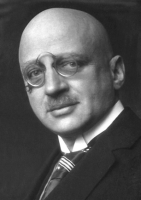










Fritz Haber (1868—1934), German physical chemist and winner of the 1918 Nobel Prize for Chemistry for his successful work on nitrogen fixation. The Haber-Bosch process combined nitrogen and hydrogen to form ammonia in industrial quantities for production of fertilizer and munitions. Haber is also well known for his supervision of the German poison gas program during World War I.
Education and career
Born to a German Jewish family in Breslau, Haber received his early education at the local gymnasium. Influenced in part by his father’s occupation as a successful importer of natural dyes and pigments, he began his study of chemistry at the University of Berlin in 1886, but he transferred to Heidelberg after a single semester. After only a year and a half at Heidelberg, Haber’s university career was interrupted by a year of military service. He then transferred to the Charlottenberg Technische Hochschule in Berlin, from which he received a doctorate in 1891 for work done under Karl Liebermann on the organic compound piperonal. Graduation was followed by three years of unrest, characterized by brief periods of industrial employment (including working for his father) interspersed with short bouts of postdoctoral study at the Technische Hochschule in Zürich and the University of Jena.
In 1894 Haber was appointed as an assistant in the Department of Chemical and Fuel Technology at the Fridericiana Technische Hochschule in Karlsruhe. Here he rapidly worked his way through the academic ranks to become a full professor in 1906. Haber remained at Karlsruhe until 1911, when he was called to head the newly founded Kaiser Wilhelm Institute for Physical Chemistry and Electrochemistry in the Berlin suburb of Dahlem. He directed the Institute until early 1933, when he resigned in protest over the newly enacted Nazi race laws. This was followed by four months of exile in England, where he worked in the laboratory of William Pope at the University of Cambridge. He died of a massive heart attack a few months later in Basel, Switz., while en route to Palestine to discuss the prospects for a position with the Daniel Sieff Research Institute, founded at Rehovot in 1934 by Chaim Weizmann, who became the first president of Israel in 1949.
Early research
Though originally trained as an organic chemist, Haber switched to the field of physical chemistry after his appointment at Karlsruhe. In keeping with the school’s engineering emphasis, his work became heavily oriented toward industrial applications. Indeed, this became the central theme of his entire research career—the elucidation and development of basic industrial processes through the application of rigorous theory. His initial work involved the physical chemistry of flames and combustion, which led to his first book, Experimental-Untersuchungen über Zerstetzung und Verbrennung von Kohlenwasserstoffen (1896; “Experimental Investigations on the Decomposition and Combustion of Hydrocarbons”). In addition to serving as a Habilitation thesis for his promotion to Privatdozent, this work would later prove valuable in elucidating the chemistry behind the refining and cracking of petroleum. Beginning about 1897, Haber added an interest in the theory and industrial applications of electrochemistry to his growing list of research themes. One result of his intensive efforts to master the literature in this field was his second book, Grundriss der technischen Elektrochemie auf theoretischer Grundlage (1898; “The Theoretical Basis of Technical Electrochemistry”). His contributions in this area include his studies of the electrochemical preparation of several important organic compounds such as nitrobenzene (1904), his study of the hydrogen-oxygen fuel cell (1907), and his pioneering work on the glass electrode (1909). Work on nitrobenzene led to a second book on electrochemistry, Die elektrolytischen Prozesse der organischen Chemie (1910; “The Electrolytic Processes of Organic Chemistry”), written in collaboration with German chemist Alexander Moser. Work on the glass electrode formed the basis for the later development of the pH meter, which measures hydrogen ion concentration, or acidity, in pH units as a function of electrical potential or voltage between suitable electrodes placed in the solution to be tested.
In 1904 Haber added yet a third research theme in the form of a growing interest in the thermodynamics of gas reactions. Here again his preliminary survey of the literature resulted in a book, Thermodynamik technischer Gasreaktionen (1905; The Thermodynamics of Technical Gas Reactions). His work in this area soon focused on the synthesis of ammonia gas from nitrogen and hydrogen gas and its potential as a method of nitrogen fixation. In 1898 the British chemist William Crookes warned that the world’s population would soon outstrip its food production unless crop yields were increased through the use of nitrogen fertilizers. Though the atmosphere is 78 percent nitrogen by volume, this nitrogen is unavailable to plants unless it is first “fixed” in the form of a water-soluble compound, such as ammonia or various nitrates. By 1908 Haber was able to show that the use of high pressures in combination with a suitable catalyst made ammonia synthesis practical, and the next year the process was turned over to the German chemist Carl Bosch at BASF Aktiengesellschaft for industrial development of what is now known as the Haber-Bosch process. In 1911 the first ammonia plant was built at Ludwigshafen-Oppau, which produced over 30 tons of fixed nitrogen per day by 1913. In 1918 Haber was awarded the Nobel Prize for Chemistry for his role in ammonia synthesis, and in 1931 Bosch belatedly received a Nobel Prize for his contributions as well.
Nobel Prize in Chemistry, Rumford Medal